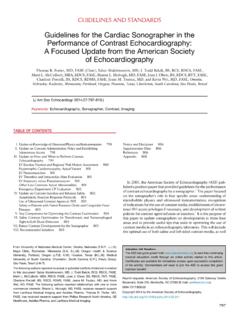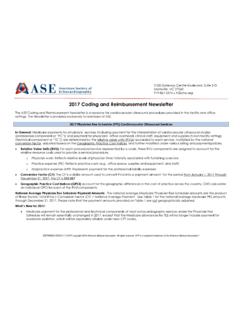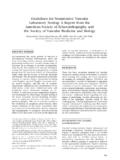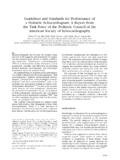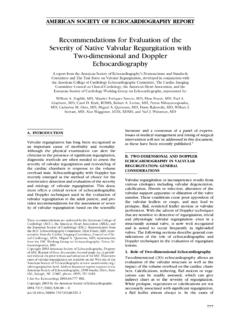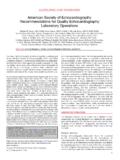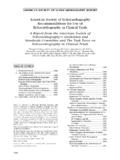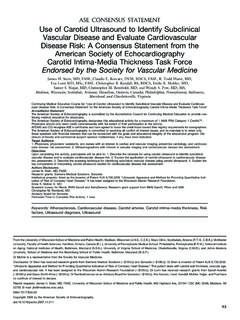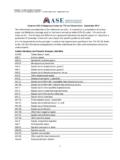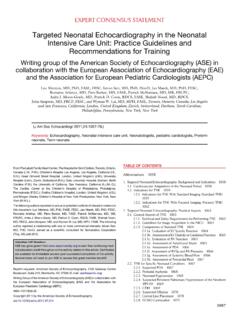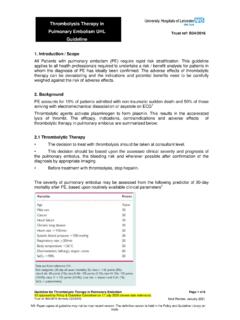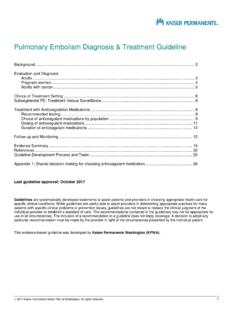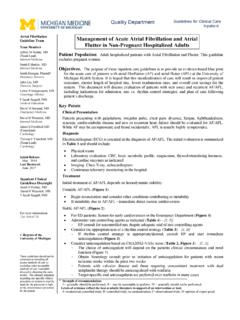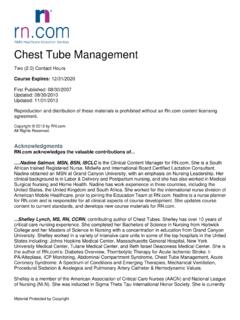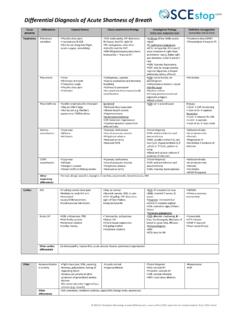Transcription of Guidelines for the Use of Echocardiography in the ...
1 ASE Guidelines AND STANDARDSG uidelines for the Use of Echocardiography in theEvaluation of a Cardiac Source of EmbolismMuhamed Saric, MD, PhD, FASE, Chair, Alicia C. Armour, MA, BS, RDCS, FASE, M. Samir Arnaout, MD,Farooq A. Chaudhry, MD, FASE, Richard A. Grimm, DO, FASE, Itzhak Kronzon, MD, FASE,Bruce F. Landeck, II, MD, FASE, Kameswari Maganti, MD, FASE, Hector I. Michelena, MD, FASE,and Kirsten Tolstrup, MD, FASE,New York, New York; Durham, North Carolina; Beirut, Lebanon; Cleveland,Ohio; Aurora, Colorado; Chicago, Illinois; Rochester, Minnesota; and Albuquerque, New MexicoEmbolism from the heart or the thoracic aorta often leads to clinically significant morbidity and mortality due totransient ischemic attack, stroke or occlusion of peripheral arteries. Transthoracic and transesophageal echo-cardiography are the key diagnostic modalities for evaluation, diagnosis, and management of stroke, systemicand pulmonary embolism .
2 This document provides comprehensive American Society of Echocardiographyguidelines on the use of Echocardiography for evaluation of cardiac sources of describes general mechanisms of stroke and systemic embolism ; the specific role of cardiac and aortic sour-ces in stroke, and systemic and pulmonary embolism ; the role of Echocardiography in evaluation, diagnosis,and management of cardiac and aortic sources of emboli including the incremental value of contrast and 3 Dechocardiography; and a brief description of alternative imaging techniques and their role in the evaluation ofcardiac sources of Guidelines are provided for each category of embolic sources including the left atrium and left atrialappendage, left ventricle, heart valves, cardiac tumors, and thoracic aorta.
3 In addition, there are recommen-dation regarding pulmonary embolism , and embolism related to cardiovascular surgery and percutaneousprocedures. The Guidelines also include a dedicated section on cardiac sources of embolism in pediatric pop-ulations. (J Am Soc Echocardiogr 2016;29:1-42.)Keywords:Cardioembolism, Cryptogenic stroke, Cardiac mass, Cardiac tumor, Cardiac shunt, Vegetation,Prosthetic valve, Aortic atherosclerosis, Intracardiac thrombusTABLE OF CONTENTSI ntroduction 3 Methodology 3 General Concepts of Stroke and Systemic embolism 3 Stroke Classification 3 Type and Relative Embolic Potential of Cardiac Sources ofEmbolism 3 Diagnostic Workup in Patients with Potential Cardiac Sources ofEmboli 4 From New York University Langone Medical Center, New York, New York ( );Duke University Health System, Durham, North Carolina ( ); AmericanUniversity of Beirut Medical Center, Beirut, Lebanon ( ); Icahn School ofMedicine at Mount Sinai Hospital, New York, New York ( ); Learner Collegeof Medicine, Cleveland Clinic, Cleveland, Ohio ( ).
4 Lenox Hill Hospital, NewYork, New York ( ); the University of Colorado School of Medicine, Aurora,Colorado ( ); Northwestern University, Chicago, Illinois ( ); Mayo Clinic,Rochester, Minnesota ( ); and the University of New Mexico HealthSciences Center, Albuquerque, New Mexico ( ).The following authors reported no actual or potential conflicts of interest in relationto this document: Muhamed Saric, MD, PhD, FASE, Chair, Alicia Armour, MA, BS,RDCS, FASE, M. Samir Arnaout, MD, Richard A. Grimm, DO, FASE, Bruce F. Land-eck, II, MD, FASE, Hector Michelena, MD, FASE, and Kirsten Tolstrup, MD, following authors reported relationships with one or more commercialinterests: Farooq Chaudhry, MD, FASE serves as a consultant for Lantheus Med-ical Imaging and received grant support from GE Healthcare and Bracco.
5 ItzhakKronzon, MD, FASE, serves as a consultant for Philips Healthcare; KameswariMaganti, MD, FASE, received a research grant from GE requests: American Society of Echocardiography , 2100 GatewayCentre Boulevard, Suite 310, Morrisville, NC 27560 ASE Members:The ASE has gone green! earn free continuingmedical education credit through an online activity related to this are available for immediate access upon successful completionof the activity. Nonmembers will need to join the ASE to access this greatmember benefit!0894-7317/$ 2016 by the American Society of andTreatment 4 Role of Echocardiographyin Evaluation of Sourcesof embolism 4 Appropriate Use Criteria forEchocardiography in Evaluationof Cardiac Sources ofEmboli 4 Appropriate Use:TransthoracicEchocardiography(TTE) 4 Appropriate Use: TEE 4 Uncertain Indication forUse: TEE 5 Inappropriate Use:TTE 5 Inappropriate Use:TEE 5A Practical Perspective.
6 EchocardiographicTechniques for Evaluation ofCardiac Sources ofEmbolism 5 Two-DimensionalHigh-Frequency andFundamentalImaging 5 Three-Dimensional andMultiplane Imaging 5 Saline and TranspulmonaryContrast 5 Color Doppler, Off-Axisand Nonstandard Viewsand Sweeps 5 TTE versus TEE 5 Recommendations forPerformance ofEchocardiography in Patientswith Potential Cardiac Sourceof embolism 8 EchocardiographyRecommended 8 EchocardiographyPotentially Useful 8 Echocardiography NotRecommended 8 TTE versus TEE 8 Alternatives to Echocardiographyin Imaging Cardiac Sources ofEmbolism 8 Computed Tomographic orMagnetic ResonanceNeuroimaging 8 Transcranial Doppler(TCD) 8 Nuclear Cardiology 9 Chest CT 9 Chest MRI 9 Recommendation forAlternative ImagingTechniques in Evaluation ofCardiac Sources ofEmbolism 10 Alternative ImagingRecommended 10 Alternative Imaging Not Recommended 10 Thromboembolism from the Left Atrium and LAA 10 Pathogenesis of Atrial Thrombogenesis and Thromboembolism 10 Echocardiographic Evaluation of the Left Atrium and LAA 13 Cardioversion 13 pulmonary Vein Isolation 14 Guidance of LAA Percutaneous Procedures 14 Recommendations for Performance of Echocardiography in Patientswith Suspected LA and LAAT hrombus 14 Echocardiography Recommended 14 Echocardiography Potentially Useful 14 Echocardiography Not Recommended 14 Thromboembolism from the Left Ventricle 14 Acute Coronary
7 Syndromes 14 Cardiomyopathy 15LV Thrombus Morphology 15 Role of Echocardiography in the Detection of LV Thrombus 15 Recommendations for Performance of Echocardiography in Patientswith Suspected LV Thrombus 16 EchocardiographyRecommended 16 EchocardiographyPotentially Useful 16 Echocardiography NotRecommended 16 Valve Disease 16 Infective Endocarditis 16 Diagnosis 16 Prognosis 18 Recommendations for Performance of Echocardiography in Patientswith Suspected IE 19 Echocardiography Recommended 19 Echocardiography Not Recommended 19 Nonbacterial Thrombotic Endocarditis 19 Verrucous Endocarditis or Libman-Sacks Endocarditis 19 Marantic Endocarditis or NBTE 20 Recommendations for Performance of Echocardiography in Patientswith Suspected Noninfective Endocarditis 21 Echocardiography Recommended 21 Echocardiography Not Recommended 21 Papillary Fibroelastomas 21 Valvular Strands and Lambl s Excrescences 21 Mitral Annular Calcification 21 Recommendations for Performance of Echocardiography in Patientswith MACs 21 Echocardiography Potentially Useful 21 Prosthetic Valve Thrombosis 21 Diagnosis 21 TEE-Guided Prosthetic Thrombosis management 23 Embolic Complications in Interventional Procedures 25 Recommendations for Performance of Echocardiography in Patientswith Prosthetic Valve Thrombosis 25 Echocardiography Recommended 25 Cardiac Tumors 25 Echocardiographic Evaluation of Cardiac Tumors 26 Myxoma 26 Papillary Fibroelastoma 27 Recommendations for Echocardiographic
8 Evaluation of CardiacTumors 27 Echocardiography Recommended 27 Echocardiography Potentially Useful 27 Echocardiography Not Recommended 27 embolism from the Thoracic Aorta 27 Role of Echocardiography in the Visualization of Aortic Plaques 29 Recommendations for Echocardiographic Evaluation of Aortic Sourcesof embolism 29 Echocardiography Recommended 29 Abbreviations2D= Two-dimensional3D= Three-dimensionalASA= Atrial septal aneurysmASD= Atrial septal defectASE= American Society ofEchocardiographyATS= Aorticthromboembolism syndromeAVM= ArteriovenousmalformationCES= Cholesterol embolisyndromeCT= Computed tomographyIE= Infective endocarditisLA= Left atriumLAA= Left atrial appendageLV= Left ventricleMAC= Mitral annularcalcificationMRI= Magnetic resonanceimagingMV= Mitral valveNBTE= Nonbacterialthrombotic endocarditisPE= pulmonary embolismPFE= Papillary fibroelastomaPFO= Patent foramen ovalePLAX= Parasternal long-axisPSAX= Parasternal shortaxisRA= Right atriumRV= Right ventricleSEC= Spontaneousechocardiographic contrastTAVR= Transcatheter aorticvalve replacementTCD= Transcranial DopplerTEE= TransesophagealechocardiographyTIA= Transient ischemicattackTTE= TransthoracicechocardiographyVSD= ventricular septaldefect2 Saric et alJournal of the American Society of EchocardiographyJanuary 2016 Echocardiography Potentially Useful 29 Echocardiography Not Recommended 29 Paradoxical embolism 29 Role of Echocardiography in Evaluation of Suspected ParadoxicalEmbolism 31 Recommendations for Echocardiographic
9 Evaluation of SuspectedParadoxical embolism 31 Echocardiography Recommended 31 Echocardiography Potentially Useful 31 Echocardiography Not Recommended 31 pulmonary embolism 32 Role of Echocardiography in Evaluation of PE 32 Recommendations for Echocardiography in Patients with SuspectedPE 33 Echocardiography Recommended 33 Echocardiography Not Recommended 33 Cardiac and Aortic embolism during Cardiac Surgery and PercutaneousInterventions 34 Cardiac Catheterization 34 Cardiac Surgery 34 Percutaneous Interventions 34 Recommendations for Echocardiography in Patients Referred forCardiac Surgery or Percutaneous Intervention 34 Echocardiography Recommended 34 Stroke in the Pediatric Population 35 Role of Echocardiography in Evaluation of Systemic embolism inPediatric Patients 35 Recommendations for Echocardiography in Pediatric Patients withSuspected Systemic embolism 35 Echocardiography Recommended 35 Echocardiography Potentially Useful 36 Notice and Disclaimer 36 Reviewers 36 Supplementary data 36 References 36 INTRODUCTIONE mbolism from the heart or the thoracic aorta often leads to clinicallysignificant morbidity and mortality due to transient ischemic attacks(TIAs), strokes, or occlusions of peripheral is the third leading cause of death in the United States , diagnosis, and management of stroke and systemic embolism accounts for approximately one third of all casesof ischemic stroke.
10 Paradoxical embolism and embolism from thethoracic aorta, especially of its atheroma contents, are responsiblefor additional cases of stroke and systemic document provides the first set of Guidelines of the AmericanSociety of Echocardiography (ASE) Guidelines specific to this Guidelines are based on an extensive literature reviewincluding allotherrelevant guidelinesfrom theASEandothernationaland international medical societies. They provide primarily expertconsensus opinions, because randomized trial data are lacking formany topics discussed in these Guidelines . Throughout these guide-lines, recommendations are provided in the same format for all : Echocardiography recom-mended, Echocardiography potentially useful, and echocardiographynot recommended. It is hoped that these Guidelines will providestandardization in the echocardiographic evaluation of patients withcardiac sources of embolism and lead to improved patient CONCEPTS OF STROKE AND SYSTEMICEMBOLISMS troke, probably embolic in origin, was first described by the Greekphysician Hippocrates (circa 460 370BC).
